Linnet Rise Flood Alleviation scheme (2017)
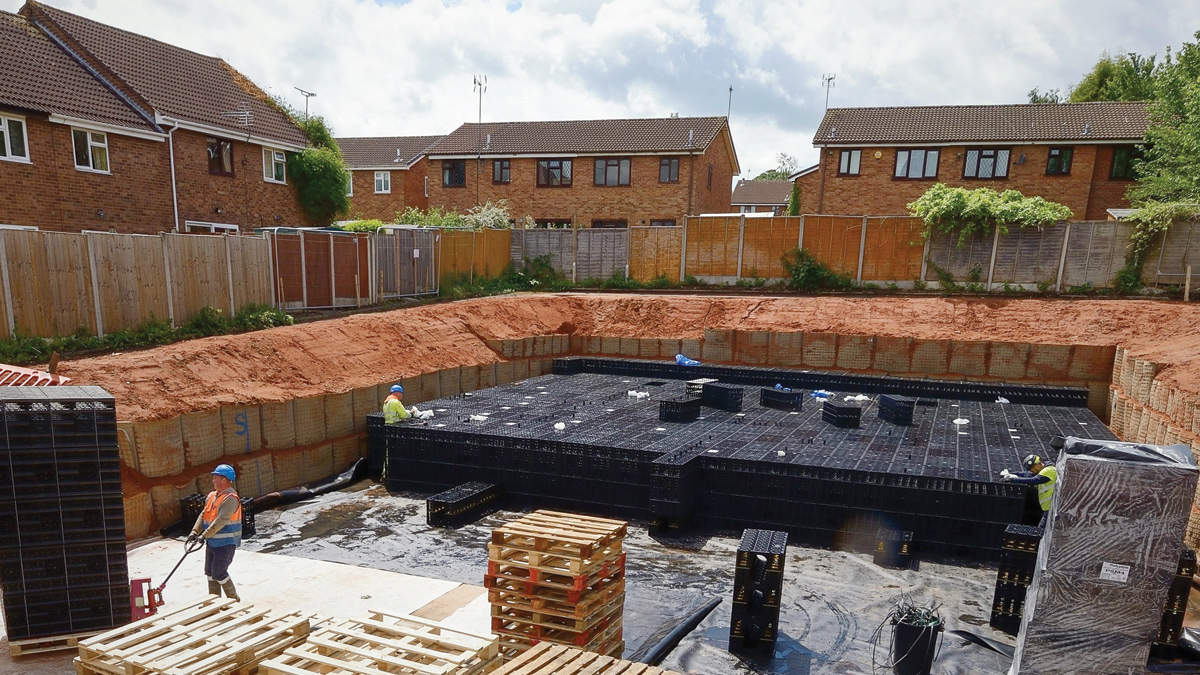
Linnet Rise Flood Alleviation Scheme under construction - Courtesy of NMCNomenca
The complexity of the flooding issues associated with the low lying properties on Linnet Rise was investigated following secured funding from Severn Trent Water. Under the AMP6 framework agreement NMCNomenca (now Galliford Try) was appointed as design and build contractor and worked closely with the STW solution team to develop the best TOTEX solution for the £1.3m scheme. During initial feasibility stages of the design, it became apparent that upsizing the existing surface water sewers to safely convey the flood waters away would prove too disruptive to local residents with the need for numerous lengthy road closures. The solution team focussed on providing the required 845m3 of attenuation required to reduce the flood return period at the affected properties to a 1 in 40 year storm event. Retrospectively designing such large storage volumes within the confines of the densely populated housing estate required innovative proposals.
Stringent hydraulics
Two existing resident owned car parks situated adjacent to the flooding properties were chosen as the most suitable area for constructing the underground tanks. In order to use the tanks most effectively and to eliminate any long term running costs the system had to fill and empty without using any pumps or valves. This led to a complex hydraulic criterion where the invert of the tanks could not be lower than the existing network and the top water level within the tanks any higher than the downstream flooding properties.
The tank layouts were dictated entirely by the stringent hydraulic conditions and required nearly the entirety of the footprint of both car parks in order to fit the required volume.
Crate thinking
Due to the residential nature of the scheme and the proximity of the neighbouring buildings, a traditional concrete tank would have proven too disruptive due to the number of construction vehicle deliveries, the need for heavy plant and the very limited working room.
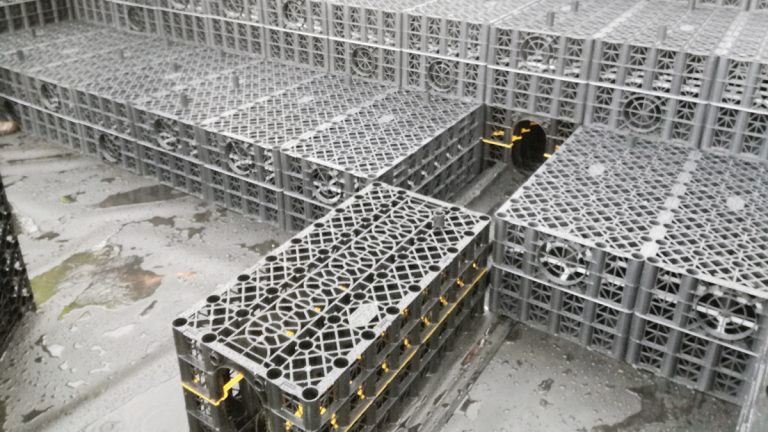
Assembly of geocellular crates with inspection channel – Courtesy of NMCNomenca
NMCNomenca suggested the use of geocellular crates, a first for STW Asset Creation, which would drastically reduce the overall programme and the installation of which is significantly less disruptive. As the scheme would displace residents out of their usual car parking spaces, the speed of installation played a crucial part in the decision making process to use geocellular crates.
Polypipe was appointed as the main supplier due to an extensive track record of previously successfully delivering this type of attenuating structure for developers and other contractors.
NMCNomenca’s drive to encourage off site manufacturing led to all of the tanks’ associated pipework, manholes and catchpits being pre-manufactured by Polypipe, these were in turn installed in a single working day, saving on programme, cost and disruption to local residents.
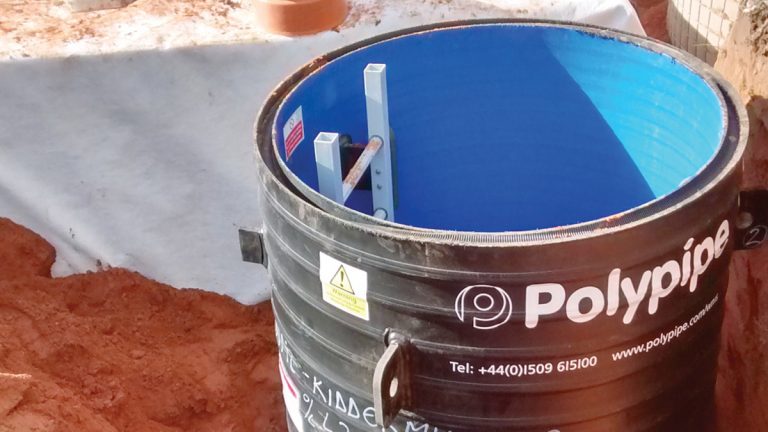
Installation of prefabricated catchpit chambers – Courtesy of NMCNomenca
Long term maintenance
The long term maintenance of the tank remained at the forefront of the design process. With both tanks acting as blind tanks (only filling when the surface water sewer is surcharging) the sewers are allowed their first flush through before spilling into the geocellular crates; minimizing the risk of mobilizing any sediment. The tanks are laid at a 1 in 150 gradient across both length and width to facilitate appropriate drain down to the bottom corner of the crates which forms the primary inlet and outlet, encouraging any sediment entering the tank to be flushed out through the same flow path.
Three channels running through each tank encourage flow dispersal through the 95% void ratio geocellular crates and provide a means of inspecting the tanks along their lengths. Specialist access turrets designed at six locations outside of the car parking bays ensure maintenance operatives have guaranteed access to the inspection channels.
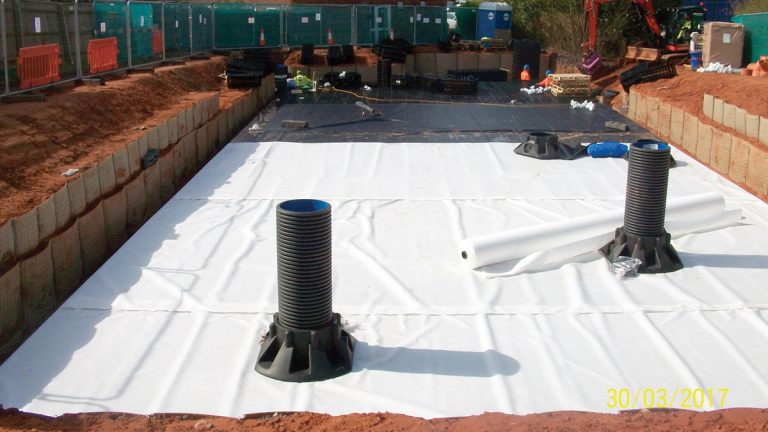
Access turrets and membrane installation – Courtesy of NMCNomenca
Temporary works
Site Investigation boreholes revealed very weak, highly weathered Bromsgrove Sandstone, which also presented a need for challenging temporary works design. Due to the very limited working room, a large battered excavation in the weak sandy ground conditions would place geotechnical subsidence risk on nearby properties. A traditional sheet and frame approach would require large disruptive pilings rigs and the 14m long props would require the installation of a temporary crane pad, an impossibility given the constraints witnessed on site.
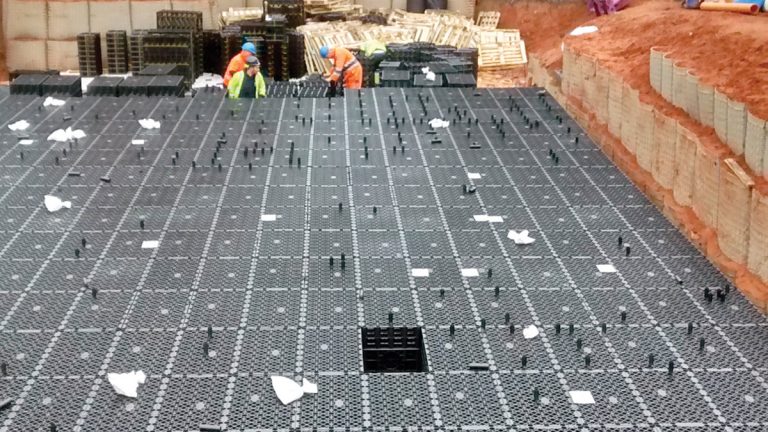
Limited working room during construction – Courtesy of NMCNomenca
NMCNomenca developed a pioneering approach of using Hesco MIL Units filled with Type 1 and as-dug sand material to act as a temporary style gabion wall design. This was installed around the perimeter of the excavation using a drag box, and consequently backfilled and buried. The main excavation for the geocellular crates could then safely be carried out within the confines of this innovative temporary works design.
Due to the sloping nature of the car park, the depth of installation at the deepest part of the structure was over 3.2m deep causing large lateral loads to the sides of the geocellular crates resulting in special measures being required to reduce this loading and prevent crushing the structure together. NMCNomenca’s chosen solution was to fill the bottom layer of Hesco baskets with a specifically sourced Type 1 material with a minimum shear resistance of 42º, which would limit the horizontal force exerted on the geocellular crates even should the membrane of the Hesco baskets deteriorate over time.
The risk of sand infiltrating and silting up the crate system led to the decision to seal the tanks with a welded impermeable membrane, the joints of which were air tested to guarantee the watertightness of the system. The tanks were further wrapped in a geotextile fleece to protect the membrane from any accidental puncturing during backfilling operations.

(left) Concertina style Hesco temporary works baskets and (right) design, build and supply team – Courtesy of NMCNomenca
Communications
It was identified at an early stage that the general public living near Linnet Rise was going to be subject to significant disruptions from the car park closures and construction related activities taking place, so a comprehensive stakeholder management plan was put into place. The team delivered continuous update letters throughout the design and build process informing the residents of the upcoming works and of progress on site.
A well-attended public consultation event took place in December 2016 using STW’s DOLLY (Delivering Our Lasting Legacy to You) mobile exhibition unit as an opportunity to explain first-hand the proposals and answer the many queries from the curious residents.
Concerns were raised by individuals over the condition of the car parks as the responsibility for the upkeep remained with the residents. NMCNomenca agreed to reinstate the entirety of both car parks with a new tarmac finish as a gesture of good will.
Lasting legacy
The Linnet Rise Flood Alleviation scheme’s legacy was further cemented by a collaborative approach to solving the wider flooding issues in the area. Worcestershire County Council acknowledged the lack of capacity in the existing highway network drainage to deal with overland flows during periods of heavy downpours and funding was agreed to incorporate the addition of six new highway gullies and the creation of a new earth bund into the scope of the project. This integrated approach realised economic savings for all parties involved and was highly commended within STW.
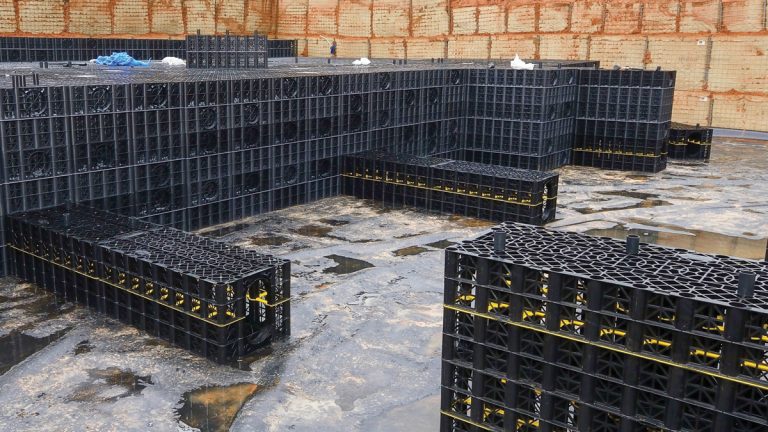
Crate installation within temporary works – Courtesy of NMCNomenca
Throughout the duration of the project, collaborative planning was implemented in order to apply product control methods to realise efficiencies in the project programme. This allowed STW, NMCNomenca and the whole supply chain to collaborate over timescales associated with each individual’s requirements.
Enthusiasm within the team to further promote the excellent health and safety record of the scheme led to the invitation of Severn Trent Water Asset Creation to visit the site during the installation of the tank in the second car park and proved to be a mutually beneficial visit to learn about the innovations witnessed on this project. Many of the lessons learnt have been shared to Seven Trent Water’s wider supply chain through publications and innovation bulletins




